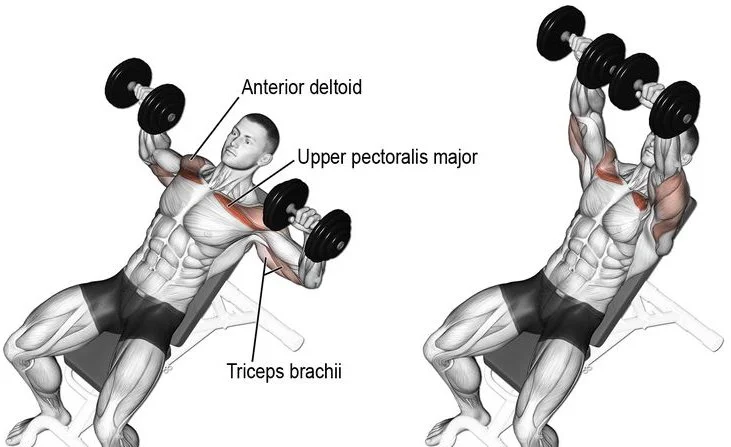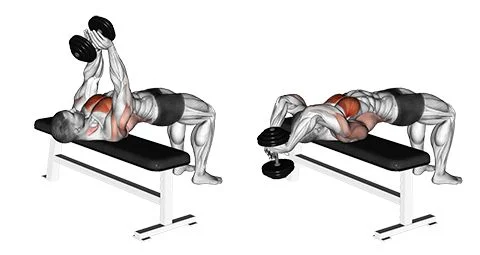Use this dumbbell lower chest workout to tone your pecs quickly and easily! It’s easy to follow, so you’ll be able to see results in a short time.
The lower part of the chest is often overlooked when it comes to chest training, but it carries the same level of importance as the upper chest when aiming for a well-developed physique. With a few dumbbell exercises that are simple, you can specifically target your lower chest area and accomplish the desired goal of having well-defined pectoral muscles.
his article will showcase the top exercises using dumbbells to effectively develop the lower chest.
Additionally, a sample workout routine will be provided for you to follow.
Understanding the Muscles in Dumbbell Lower Chest Workout
The pectoralis inferior, also known as the lower chest muscles, play a significant role in pushing movements and are situated beneath the upper chest muscles. Strengthening these muscles enhances not only the development of the chest but also boosts overall strength and power.
The advantages of incorporating a Dumbbell Lower Chest Workout
There are many benefits to doing a dumbbell lower chest workout, including:
- Increased muscle growth: Dumbbell workouts have a wider range of motion than barbell exercises, which can result in more muscular growth.
- Improved strength: Exercises using dumbbells help you become stronger in both pushing and pulling.
- Enhanced definition: By targeting your lower chest, you can create a more defined and sculpted chest.
- Reduced injury risk: Because dumbbell workouts put less strain on your joints than barbell exercises, they are generally seen as safer.
7 exercises using dumbbells that target the lower chest.
1. Decline Dumbbell Bench Press
A variation on the well-liked flat bench press chest workout is the decline dumbbell bench press. Here, the torso is positioned at an angle rather than flat on the bench since the bench is adjusted to a roughly 30-degree descent.
Compared to a typical flat press, the exercise bench’s downward slope tilt helps to more efficiently target certain chest muscles with each completed push. Dumbbells, as the name implies, are used in place of barbells.
Muscles Targeted
Dumbbell presses are an excellent exercise for developing lower chest muscles because they allow the lower pectoral muscles to bear the brunt of the effort due to the body’s downward inclination on the bench.
Step-By-Step Guide
- Put your knees up above your head and slowly lower yourself onto the end of a decline bench.
- Raise the dumbbells to the beginning position in the air by rotating your wrists so that your palms are facing away from you.
- Simultaneously lower the dumbbells on both sides of your chest until your elbows are at a straight angle. Return to the beginning position by pushing upward, then repeat.
Advice for getting the most out of the exercise
- Make sure your forearms are parallel to the ground.
- Dumbbells should be lowered gradually to the chest.
- Breathe in as you descend, and out as you ascend.
- It works well to perform three sets of eight to ten reps.
2. Decline Dumbbell Chest Fly
Similar to the decline dumbbell bench press, the decline dumbbell chest fly focuses mainly on strengthening the chest muscles.
The manner the weights are moved during each chest fly makes a big difference in this exercise, not where the body is positioned on the bench.
Muscles Targeted
Both the deltoids and pectoral muscles are worked during this workout.
Step-By-Step Guide
- With a pair of dumbbells in each hand, lie down with your torso slanted downward and secure your legs on the end of a decline bench.
- Swing your palms so they are facing each other while you raise the weights higher. This is where everything begins.
- Keep your elbows bent as you lower the weights toward your sides.
- When the weights have been moved down to the desired level, the chest muscles should start to stretch.
Advice for doing the workout well
- Even when you press the dumbbells upward, maintain a slight bend in your arms.
- After the weights are dropped, each chest fly should be performed gently and followed by a little break.
- Do two or three sets of six or ten repetitions.
3. Bench press dumbbells with a neutral grip
You perform a dumbbell bench press with a neutral grip while lying flat and without an inclination. This is the only significant distinction between this exercise and the two decline workouts that were previously discussed.
Muscles Targeted
A dumbbell bench press with a neutral grip works the triceps, biceps, and pecs.
Step-By-Step Guide
- Lie flat on a standard training bench with your legs apart and your feet firmly on the floor.
- Make sure to raise the dumbbells until your arms are straight, ensuring that your palms are facing each other.
- Tighten your elbows to your sides and pull the dumbbells downwards, then lift them back up until your arms are fully extended.
useful tips for effectively performing the exercise.
- Always ensure that your back remains flat on the bench throughout.
- Use the shoulders to apply pressure.
- Lower the weights gradually until you experience a gentle stretching sensation in your chest muscles.
- Breathe out while you push down and breathe in while you push up.
- Performing three sets of ten repetitions will effectively target the muscles in the chest.
4. Incline Dumbbell Bench Press

An incline dumbbell bench press, as its name suggests, involves starting with the upper body slightly elevated compared to the waist and legs.
Muscles Targeted
The focus of this specific exercise is on the shoulders, biceps, and pectoral muscles.
Step-By-Step Guide
- Grab the dumbbells, then position yourself at the edge of the bench, ensuring the dumbbells are placed on your knees.
- Lay on your back with your knees bent and legs spread apart.
- Start by positioning your elbows at right angles, while facing your palms away from you, push the dumbbells outwards to your sides. Remember, this is the starting position.
- Make sure to extend your chest outwards, then bring the dumbbells down towards your chest. Finally, push them back up to the starting position.
Tips for Performing the Exercise Effectively
- Make sure to keep your feet firmly planted on the ground and ensure that your legs remain still throughout.
- Remember to maintain a straight alignment of your wrists during the upward motion, and aim to achieve a 90-degree angle with your elbows when pushing down.
- As you go down, breathe in, and as you come up, exhale.
- You can try performing three to four sets of six to ten repetitions of this exercise.
5. Close Grip Dumbbell Bench Press

Performing a close-grip dumbbell bench press compels the chest muscles to contract more intensely due to the positioning of the dumbbells, which are brought closer together rather than being held apart widely.
The muscles targeted
This exercise activates the lower chest muscles, shoulders, biceps, and triceps.
Step-By-Step Guide
- Grab the dumbbells and position yourself at the edge of the bench, placing the dumbbells on your knees.
- To get into position, lay flat on your back with your knees bent and feet firmly planted.
- Push the dumbbells upwards with your palms facing each other until your arms are fully extended.
- Bring the dumbbells close together until they make contact.
- While holding the dumbbells close together, slowly bring them down until they reach your chest.
- Straighten your arms by pushing the dumbbells back up.
Tips for Performing the Exercise Effectively
- Remember to keep your elbows close to your sides while lowering the weights.
- You should aim to complete three sets of 12 to 15 repetitions.
6. Single Arm Dumbbell Bench Press
In the exercise known as single-arm dumbbell bench press, one arm assumes the full weight of a dumbbell while the body maintains a bench press position. It is recommended to begin this exercise with lighter weights in order to gradually strengthen the muscles in the arms and chest.
The targeted muscles.
When one side of the body bears the weight, it activates muscles in the forearms, biceps, triceps, core, and chest. The core will attempt to rectify this imbalance automatically.
Step-By-Step Guide
- Sit at the edge of a bench, with your legs spread wide and a solitary dumbbell positioned between your legs.
- Lie down and lift the weight with your palm facing away from your body until your arm is fully extended at the elbow.
- Then, slowly lower the dumbbell until your elbow creates a perfect 90-degree angle.
- Slowly lift the weight again and repeat the action.
- To evenly work both sides of the chest, switch hands.
Tips for Performing the Exercise Effectively
- You can incorporate this secondary exercise into your primary chest workout.
- Make sure to perform each press at a slow and controlled pace.
- To properly complete your workout, aim to perform ten arm presses on each arm for one to two sets.
7. Dumbbell Pullover

The exercise known as the dumbbell pullover derives its name from the motion of pulling over, which is used to target the chest muscles. The activity requires lying on a bench while employing a single dumbbell to target and strengthen the entire chest area. The position to begin with is quite unusual as the dumbbell is positioned behind the head.
The muscles that are targeted.
The shoulders and arms are flexed in this posture, but the primary focus is on the pullover action, which effectively engages the chest muscles.
Step-By-Step Guide
- Lie on a bench with your back flush against the surface and your feet positioned wide apart on the ground.
- Gently place one end of the dumbbell on your chest.
- Please use both of your hands to provide support for the opposite end of the dumbbell weight.
- Extend your arms outward to position the dumbbell behind your head; this will be considered the starting position.
- To perform a dumbbell pullover, maintain straight arms while guiding the dumbbell up and over your chest.
- Can you gradually lower your arms back down until your biceps are positioned next to your ears to complete the repetitions?
Tips for Performing the Exercise Effectively
- To prevent injuries, it is best to initially opt for a lighter weight.
- Gently tug until you sense the muscles in your chest becoming taut.
- You should attempt performing two to three sets of ten to 15 repetitions.
Lower Chest Workout using Dumbbells
Here’s a sample dumbbell lower chest workout routine to incorporate into your training program:
Warm-up:
- It is recommended to engage in 5-10 minutes of light cardio exercises, such as jogging or performing jumping jacks.
dumbbell lower chest workout:
| Exercises | Sets | Reps |
|---|---|---|
| Decline Dumbbell Bench Press | 4 | 8-10 |
| Decline Dumbbell Chest Fly | 4 | 8-10 |
| Neutral Grip Dumbbell Bench Press | 3 | 8-12 |
| Incline Dumbbell Bench Press | 3 | 8-12 |
| Twisting Dumbbell Bench Press | 4 | 8-10 |
| Close Grip Dumbbell Bench Press | 3 | 8-12 |
| Dumbbell Pullover | 4 | 8-10 |
Cool-down:
- For 5-10 minutes, engage in stretching exercises that specifically target the chest muscles.
The bottom line
With a few simple dumbbell exercises, you can target your lower chest and achieve the sculpted pecs you’ve always wanted. Just be sure to use a weight that is challenging but allows you to maintain good form, focus on contracting your lower chest muscles throughout each exercise, rest for 30-60 seconds between sets, and include dumbbell lower chest exercises in your dumbbell lower chest workout routine 1-2 times per week.





